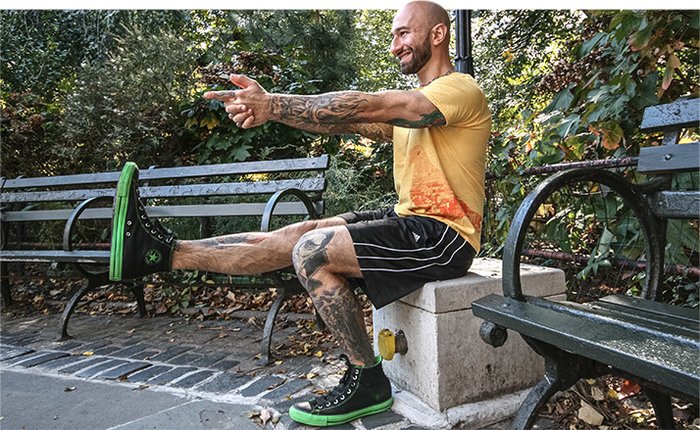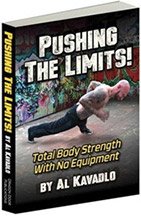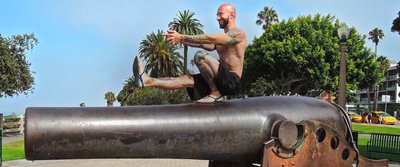When I began my fitness journey in the early '90s, machines and free weights ruled the world of strength. But recently, the pendulum of popular fitness has begun swinging back toward the minimalist end of the spectrum, and advanced calisthenics exercises like the pistol squat have been getting a lot more attention.
Pistol Squat Progression Watch The Video - 01:48
You can see them in a wide range of programs, from pure calisthenics to kettlebells and even circuit training. While I'm obviously excited to see bodyweight strength training getting its due from the mainstream, it makes me wonder: Where does the pistol squat fit in to the fitness regimen of the average gym goer?
Why Do Pistol Squats?
- Symmetry: Pistols can help eradicate imbalances between the two sides of the body.
- Simplicity: Pistols build monstrously strong legs without needing to go to the gym.
- Efficiency: Pistols simultaneously train strength, balance, and mobility with just one exercise.
Though many may think they can start right in with this exercise, the truth is that fitness pros often get so eager to show off a cool-looking new move or technique that they forget it's inappropriate for 95 percent of the general population.
Even if you've been strength training for a long time, performing a one-legged bodyweight squat with your opposite leg held in front is a unique skill that requires patience and practice to master.
Though the pistol squat is my favorite lower-body exercise in my own training, I recognize it's not appropriate for most of my clients—yet. It may be a nice long-term goal for many of them to work toward, but they need to be realistic, and so do I as their coach. Just like you wouldn't load 300 pounds onto the bar if you were teaching a beginner to do a deadlift, you can't jump right into a full pistol squat with a novice, or even intermediate-level athlete.
Before you even think about beginning to work specifically toward a pistol, make sure you can do at least 40 consecutive two-legged bodyweight squats with a full range of motion. Until you can, you shouldn't worry about any of these variants. Assuming that prerequisite has been met, however, here are a few progressive variations that you can use to work your way up to a full pistol squat ... and beyond!
Bench Pistol

Stand right in front of a bench, box or other low object and reach one leg into the air. Now sit back onto the object as slowly as you can. You'll likely lose control on the way down the first bunch of times— this is fine.
Plop down if you have to, then squeeze your abs—and your whole body—as you reach your arms out in front and pitch yourself forward to get up. Over time work toward squatting onto a lower object.
Assisted Pistol
Stand in front of a pole, doorframe or any other sturdy, vertical object that allows you to reach your opposite leg around it. Grasp the object with your hands and lower yourself down to the bottom of the pistol position with the heel of your squatting leg remaining flat on the floor. From here, lightly use your arms for assistance to pull yourself back to the top and keep your balance.

Focus on doing as much of the work as possible with your leg, only using your arms to make up the difference. You may need to use your arms a lot at first, but as your legs get stronger, you'll rely on your upper body less and less.
Elevated Pistol
Stand on top of an object with one leg hanging off of the side. Reach your arms in front and slowly lower to the bottom of a squat while your opposite leg drops below your squatting leg. Allowing your extended leg to hang down gives you more favorable leverage to complete the squat. It's also easier to balance this way as opposed to holding your free leg straight out in front.
When you've built up to a few good reps, you should try practicing on something lower. Ideally, you'll be able to find a platform just high enough to keep your outstretched foot from dragging on the ground.
Counterweighted Pistol

Pistols are one of those rare exercises that can actually be made easier for most people by adding weight—to a point, anyway. Holding a dumbbell or other heavy object in front of your chest can keep you balanced by pulling you forward, offsetting the weight of your hips moving back on the way down. Start with 10 or 15 pounds, gradually moving toward lighter weights as your balance improves.
Pistol Perfect
In theory, anyone who can do a full range-of-motion barbell back squat with their body weight on the bar should be able to do a pistol. In reality, this is rarely the case. The core strength, balance, and coordination needed to perform the pistol are unique and require skill-specific work.

Like anyone else, I had to put in my time and learn the mechanics of this move the old-fashioned way: practice. If I make pistols look easy, it's only because I've been practicing them consistently for more than a decade. A beginner should not expect to get a pistol without months—or possibly years—of dedicated training. Work your way through the progressions, milking each step for all you can.
Once you've built the strength and control to perform lots of standard pistol squats, there is still room to continue to challenge yourself. If pistols with your arms held in front are becoming too easy, try placing your hands behind your back; this simple change in leverage will make the move significantly more difficult. If you've become advanced with one-legged squats, you can begin to explore plyometric jumping pistols. The sky's the limit!
Wow, Strong Legs!
No matter your current strength level, these variations on the one-legged squat are relevant for anyone interested in building serious leg strength. Include them on your leg day along with weighted two-legged squats or practice them a few times each week as part of a full-body calisthenics program. Build up to 3-5 sets of 5-10 quality reps before moving on to the next step.
That may sound like an endless commitment, but remember that each of these steps is a unique and valuable strength challenge in and of itself, and you will see benefits from them. Take your time working through this progression and respect your level. If you are dedicated in your practice, you'll eventually get to the full pistol squat. Good things come to those who train!


